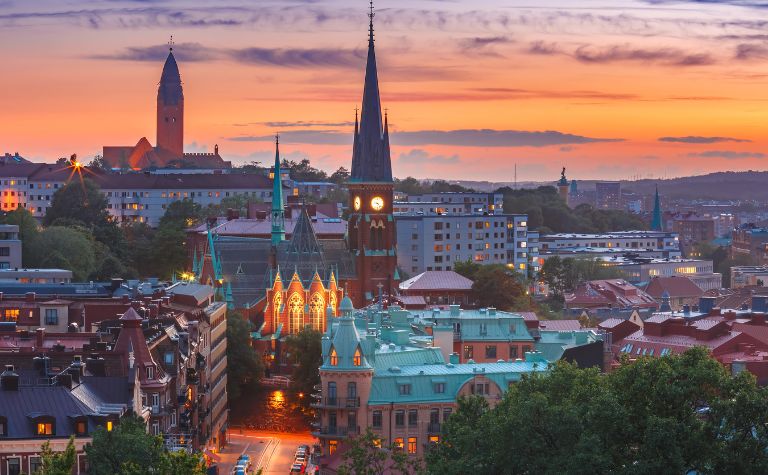Explore how the tradition of placing lights in Swedish windows has evolved over time, examining its current expressions, cultural influence, and continued relevance in the modern context.
This illuminating tradition adds a unique glow to Sweden’s winter landscape.
Today, Swedes commonly use Advent stars and candelabra as window lights, maintaining the tradition’s significance.
Influencing Swedish design aesthetics and symbolizing hospitality, these lights brighten the winter landscape, reflecting the country’s resilience and sense of community.
How does the Swedish value of comfort relate to illuminated windows? How is Saint Lucia’s Day related to this custom? Why is Christian Advent important to this practice?
Keep reading to learn the answers to these questions and others.
Also, see How Big is Sweden? to learn more.

Historical and Cultural Origins Illuminated Windows
Understanding the tradition of placing lights in windows in Sweden requires delving into the nation’s cultural and historical fabric.
This practice is closely tied to the concept of “mysig,” a uniquely Swedish term.
Mysig is a Swedish concept roughly translated to “cozy.” It encompasses creating a warm, inviting atmosphere, often through simple comforts like a warm drink or soft lighting.
Central to the idea of mysig is the creation of a warm, inviting atmosphere, and light plays a pivotal role in achieving this.
The warm glow from a window is seen as a beacon of hospitality and homeliness in the often dark and cold Swedish landscape.
Saint Lucia’s Day
Moreover, the custom of window lighting is also rooted in both pagan and Christian traditions that hold light as a powerful symbol. One of the most prominent examples is the celebration of Saint Lucia’s Day on December 13th.
This festival of lights, rooted in Christian tradition, is a tribute to Saint Lucia, which is symbolically represented as bringing light in the midst of the darkest time of the year.
During the celebration, you’ll find homes and public places adorned with candles and lights, reinforcing the theme of light overcoming darkness.
Finally, the use of light as a strategy to combat the long, harsh Scandinavian winters is a practical reason behind this custom.
During winter, Sweden experiences extremely short daylight hours, with the northernmost part of the country even plunging into the polar night—a period when the sun doesn’t rise above the horizon.
In these conditions, the illumination from windows serves not just an aesthetic purpose but a functional one, too, providing much-needed light and helping to lift the spirits during the dark winter months.
In essence, the tradition of placing lights in windows is deeply ingrained in Swedish culture, an amalgamation of cultural values, religious symbolism, and practical necessity.
It’s a testament to the Swedish ability to create warmth and joy, even in the face of long, harsh winters.

Putting Lights in Windows Today
The tradition of placing lights in windows remains a vibrant part of Swedish life today, evolved in form yet firmly rooted in its historical and cultural origins.
There are various types of window lights that one might see while walking through Swedish neighborhoods, particularly during the winter months.
Advent stars and Advent candelabra are among the most commonly spotted lights.
The Advent star, often made from paper or metal and illuminated from within, is a popular decoration during the Advent period leading up to Christmas.
The Advent candelabra, a linear arrangement of seven or nine electric candles, is another fixture you’ll frequently see gracing Swedish windows.
These modern adaptations, while convenient and safe, still carry the historical symbolism of light during the darkest time of the year.
Influencing more than just individual homes, this custom has also impacted Swedish design aesthetics, contributing to the minimalist, warm, and inviting ambiance that Swedish design is renowned for.
Lighting designers in Sweden are globally recognized for their innovative and beautiful designs that often incorporate the themes of nature, light, and simplicity.
Beyond aesthetics and tradition, the lights in windows continue to symbolize a sense of hospitality and community spirit.
In the darker months, the sight of a lit window can evoke a feeling of warmth and togetherness, maintaining its role as a beacon of hospitality.
It’s a subtle reminder of the collective resilience of Swedes during the challenging winter season, reflecting a sense of shared experience and unity.
In essence, the modern practice of placing lights in windows in Sweden is an enduring tradition that has adapted to the times.
It remains a significant aspect of Swedish life, intertwining the practical with the symbolic and adding a distinctive glow to the country’s winter landscape.
Experiencing Swedish Culture
The journey exploring why Swedes put lights in their windows has offered an enlightening perspective on Swedish customs.
This practice, born out of the need for warmth and light during long winters, and steeped in both historical and cultural significance, continues to be a vibrant part of Swedish life today.
Despite modernization and changes in lifestyle, the essence of the tradition remains intact.
The charming glow of an Advent star or candelabra in a window continues to convey a warm Swedish welcome, keeping the spirit of hospitality, unity, and resilience alive.
The role of light in Swedish design further attests to the enduring impact of this tradition.
This exploration underscores that the lights in Swedish windows are more than just decorative elements.
They serve as a beacon of the Swedish ethos of creating comfort and warmth, embodying the concept of mysig.
In the midst of winter, these lights continue to triumph over darkness, offering a shining example of how a simple custom can encapsulate the spirit of a nation.
As our exploration concludes, it becomes clear that the tradition of placing lights in windows is much more than just an aesthetic practice—it is a symbol of the Swedish heart.
It serves as a reminder that even in the darkest times, there is always a warm, welcoming glow to guide us home.
